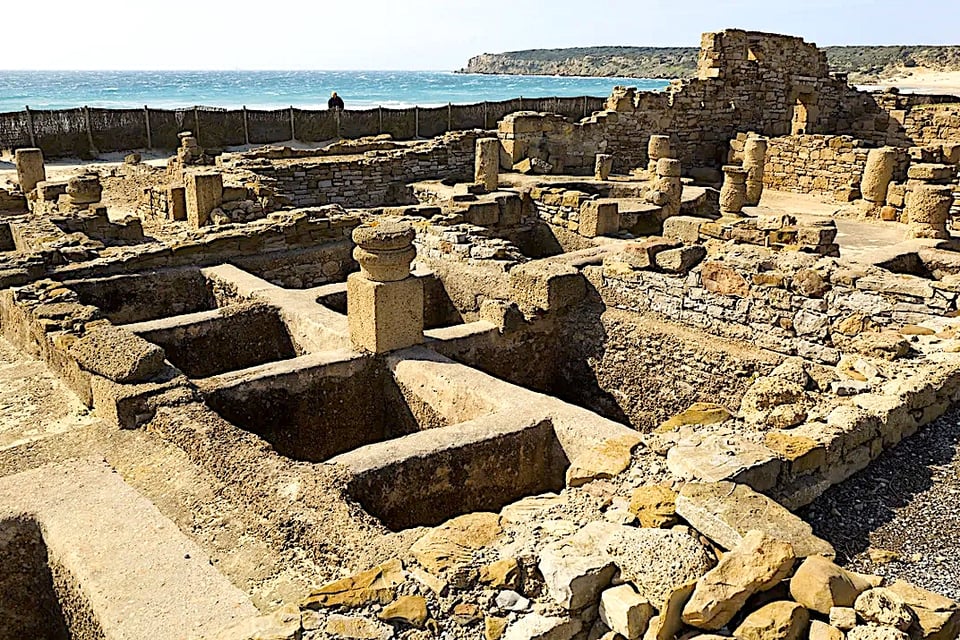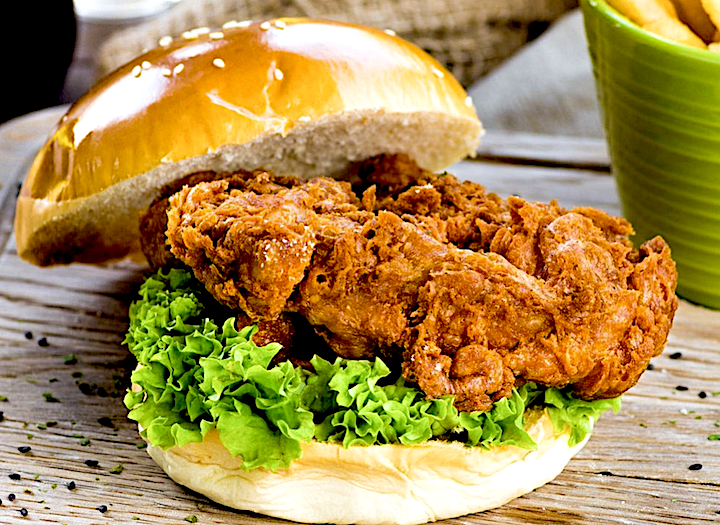Notable Sandwiches #86: Har Cheong Gai Burger
By David Swanson

Welcome back to Notable Sandwiches, the feature where Talia and I trip merrily through the baffling and mercurial document that is Wikipedia’s List of Notable Sandwiches, in alphabetical order. This week, a Singapore specialty: the har cheong gai burger.

Look at the headlines or turn on the news, and the old maxim that war is hell feels inescapable. But I remember one war that wasn’t quite so hellish, one fought on our social media feeds and in late night monologues, on our tastebuds in our stomachs; one fought not for a casus belli, but a casus belly. When the first shots of the Fried Chicken Sandwich Wars rang out in the Summer of 2019, I was right in the thick of it. Popeyes, which kicked off the hostilities with the launch of their spicy chicken sandwich that August, had a location in my neighborhood, where lines extended down the block—a major inconvenience given the frequency of my habit. Chick-fil-A, Popeyes' primary antagonist, had recently opened their biggest ever location near my office; it was similarly mobbed. The conflict soon drew in new combatants: KFC, Wendy’s, Carl’s Jr., Jack-in-the-Box, Burger King. David Chang launched his Fuku franchise, Shake Shack got into the action. It seemed as if every other eatery around was suddenly selling fried chicken sandwiches, and I wasn't complaining. I love the smell of chicken in the morning. It smells like... well, better than napalm.
Little did we know it at the time, but twelve months earlier and half a world away, McDonald’s in Singapore was slinging its very own limited-edition fried chicken sandwich. The “Ha Ha Cheong Gai Burger” was McDonald’s spin on one of the city's most iconic treats. A har cheong gai burger—literally, “shrimp paste chicken” burger—is a staple of the Singapore's lauded food hawker centers, even though it looks like your standard fried chicken sandwiches: crispy fried filet, mayo, lettuce, bun. But the chicken is marinated in a batter spiked with shrimp paste, an ingredient that is indispensable in Southeast Asian cooking, but foreign to most American palates.

This is a shame, because for a very long time the most foundational building block of western cuisine was a condiment that wouldn't be out of place in a Singapore kitchen today. In fact, augmenting the flavor of one’s food with putrified seafood waste holds a mysterious but distinguished place in Western cooking. I write of garum, the long lost condiment that seasoned the Roman Empire for eons, the holy grail of gastronomic history. Garum warrants a brief detour.
"It is prepared from the intestines of fish and various parts which would otherwise be thrown away, macerated in salt; so that it is, in fact, the result of their putrefaction," wrote Pliny the Elder in Natural History. "Garum, has been blended to the colour of old honey wine, and to a taste so pleasant that it can be drunk. But another kind of garum is devoted to superstitious sex-abstinence and Jewish rites." Pliny, who called garum that “exquisite liquid”, perished during a rescue mission to Pompeii after the eruption of Mt. Vesuvius. Pompeii was a center of the garum industry—among the city’s wealthiest residents, Aulus Umbricius Scaurus was a 1st Century fish sauce magnate whose factory produced various grades of the liquid, including a kosher version for the Roman Empire’s Jewish citizens. It was through an analysis of garum residue taken from one of Scaurus’ amphorae that archaeologists were able to date the eruption of Mt. Vesuvius to 79 AD.

According to Mark Kurlansky’s invaluable Salt: A World History, “Roman writings mention four classes of sauce: garum, liquamen, allec, and muria. The exact meaning of these terms has been lost. Allec may have been the leftover sludge after the sauce was strained. Garum and liquamen ended up being generic terms for fermented fish sauce." In one guise or the other, it appears in almost every recipe in Apicius’ De Re Coquinaria, the only cookbook we have from ancient Rome. Not everyone was a fan, however. “Do you not realize that garum sociorum, that expensive bloody mass of decayed fish, consumes the stomach with its salted putrefaction?” Seneca asked (rhetorically, I presume.)
The proper instructions for the manufacture of garum are, tragically, among the library knowledge that was lost with the fall of the Roman Empire. Whether it was due to the rising cost of salt, or to the decline in trade because of piracy, we don't know, but it would be a millennia before Europeans again experienced the glorious funk that fermented seafood can impart on one’s food. Luckily, in Southeast Asia, they never stopped experiencing it.
In 1687, Simon de La Loubère, French envoy to the Royal Court of Siam, described his hosts’ affection for “a liquid sauce, like mustard, which is only corrupted crayfish.” Two decades later, the English explorer and pirate William Dampier encountered shrimp paste for the first time in Tonkin, Vietnam. “The aroma is very strong, he wrote. “However, after adding a little part of it, the dish's flavour became quite savory."
The Sword and the Sandwich is a newsletter about deadly serious extremism and serious sandwiches. Please consider supporting this work with a paid subscription.
This savory quality Dampier identified we now know as umami, the fifth taste, isolated by Japanese chemist Kikunae Ikeda in 1907. Umami was the very essence of garum, just as it remains the essence of fish sauces and shrimp pastes to this day. The kinship between these Asian staples and Mediterranean cooking was illustrated in 2019 when David Chang posted a clip in which he seasoned his spaghetti with Thai fish sauce. Some commenters were horrified. Others were nonplussed. After all, they pointed out, fish sauce has an esteemed place in Italian cuisine going back millennia. I know I felt this way—I too add fish sauce to my ragu, as well as marinades, stir fries, roast vegetables, and anything else I can think of. And if I had some authentic garum handy, I suspect I’d use plenty of that as well.
All this should go some way towards explaining why the har cheong gai burger holds so much appeal for me. For starters, it’s a pretty basic fried chicken sandwich, which is a very good thing to be. But it’s also the definitive fried chicken sandwich of Singapore, which has some claim to the title of culinary capital of the world. And perhaps most importantly, I've long-since been radicalized by the wonders of Asian fried chicken. The primary agent for this was an addiction to “Ike’s Fish Sauce Wings” at Pok Pok Ny, a restaurant whose closing at the start of the chicken wars gutted me like garum-bound anchovy. Those wings may in fact be the single food I yearn for most, and I’ve been chasing that dragon ever since. The fact that the secret ingredient to the har cheong gai burger is fermented seafood, which was also the secret ingredient in the greatest fried chicken of my life, the chicken I still dream of? It sounds pretty perfect.

We’re probably ready for another Fried Chicken War, another silly conflict to distract us from all of the madness and horror around us. Only this time the Fried Chicken War should be global. The French can send their cordon bleu, the Chinese their Hainanese fried chicken, the Italians their chicken parm, the Germans (or Aussies) their schnitzel, the Korean’s their twice fried wings, the Irish their chicken fillet rolls. I don’t know if Vietnam or America gets to claim Ike’s Wings from Pok Pok, but I’m okay with Popeyes repping the US. Competing for Singapore, I have little doubt, would be the beloved har cheong gai burger. War is hell—that truth has been etched in time, dulce et decorum est, and all that—but if I were to make an exception, it might be for this. To see Singapore riding into the breach, armed with a weapon long unused in the arsenal of the West, a Greek Fire for the belly. And then, in the crispy, pungent fallout, we might recognize the wonders buried in our past.

Add a comment: